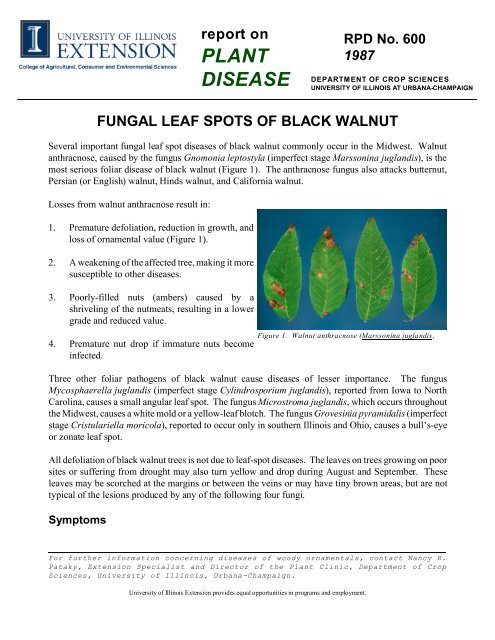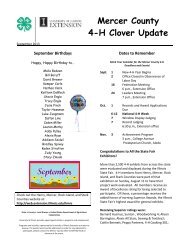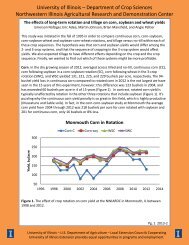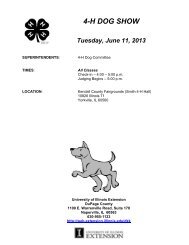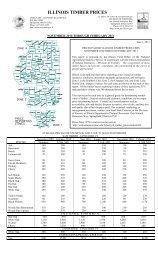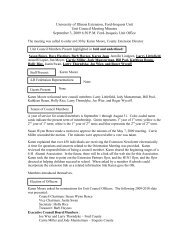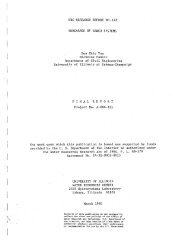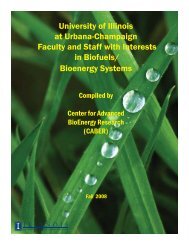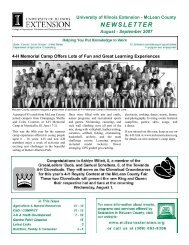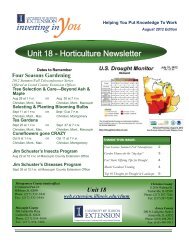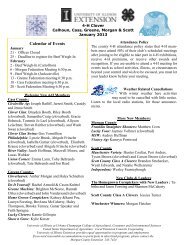Fungal Leaf Spots of Black Walnut - University of Illinois Extension ...
Fungal Leaf Spots of Black Walnut - University of Illinois Extension ...
Fungal Leaf Spots of Black Walnut - University of Illinois Extension ...
You also want an ePaper? Increase the reach of your titles
YUMPU automatically turns print PDFs into web optimized ePapers that Google loves.
FUNGAL LEAF SPOTS OF BLACK WALNUT<br />
Several important fungal leaf spot diseases <strong>of</strong> black walnut commonly occur in the Midwest. <strong>Walnut</strong><br />
anthracnose, caused by the fungus Gnomonia leptostyla (imperfect stage Marssonina juglandis), is the<br />
most serious foliar disease <strong>of</strong> black walnut (Figure 1). The anthracnose fungus also attacks butternut,<br />
Persian (or English) walnut, Hinds walnut, and California walnut.<br />
Losses from walnut anthracnose result in:<br />
1. Premature defoliation, reduction in growth, and<br />
loss <strong>of</strong> ornamental value (Figure 1).<br />
2. A weakening <strong>of</strong> the affected tree, making it more<br />
susceptible to other diseases.<br />
3. Poorly-filled nuts (ambers) caused by a<br />
shriveling <strong>of</strong> the nutmeats, resulting in a lower<br />
grade and reduced value.<br />
4. Premature nut drop if immature nuts become<br />
infected.<br />
Figure 1. <strong>Walnut</strong> anthracnose (Marssonina juglandis,<br />
Three other foliar pathogens <strong>of</strong> black walnut cause diseases <strong>of</strong> lesser importance. The fungus<br />
Mycosphaerella juglandis (imperfect stage Cylindrosporium juglandis), reported from Iowa to North<br />
Carolina, causes a small angular leaf spot. The fungus Microstroma juglandis, which occurs throughout<br />
the Midwest, causes a white mold or a yellow-leaf blotch. The fungus Grovesinia pyramidalis (imperfect<br />
stage Cristulariella moricola), reported to occur only in southern <strong>Illinois</strong> and Ohio, causes a bull’s-eye<br />
or zonate leaf spot.<br />
All defoliation <strong>of</strong> black walnut trees is not due to leaf-spot diseases. The leaves on trees growing on poor<br />
sites or suffering from drought may also turn yellow and drop during August and September. These<br />
leaves may be scorched at the margins or between the veins or may have tiny brown areas, but are not<br />
typical <strong>of</strong> the lesions produced by any <strong>of</strong> the following four fungi.<br />
Symptoms<br />
report on<br />
PLANT<br />
DISEASE<br />
For further information concerning diseases <strong>of</strong> woody ornamentals, contact Nancy R.<br />
Pataky, <strong>Extension</strong> Specialist and Director <strong>of</strong> the Plant Clinic, Department <strong>of</strong> Crop<br />
Sciences, <strong>University</strong> <strong>of</strong> <strong>Illinois</strong>, Urbana-Champaign.<br />
<strong>University</strong> <strong>of</strong> <strong>Illinois</strong> <strong>Extension</strong> provides equal opportunities in programs and employment.<br />
RPD No. 600<br />
1987<br />
DEPARTMENT OF CROP SCIENCES<br />
UNIVERSITY OF ILLINOIS AT URBANA-CHAMPAIGN
-2-<br />
1. Anthracnose symptoms appear on the leaflets as small, circular to irregularly shaped, brown-to-black<br />
areas averaging 5 millimeters in diameter, <strong>of</strong>ten surrounded by a yellowish halo (Figure 2A). One<br />
or more lesions may develop on a leaflet and the spots may later merge to form large, blighted areas<br />
(Figure 2B). Very small black bumps, fruiting bodies (Acervuli) <strong>of</strong> the anthracnose fungus, are<br />
abundant on older lesions, especially on the underside <strong>of</strong> the leaflet near the veins (Figure 3). The<br />
Figure 2 (Left). <strong>Walnut</strong> anthracnose lesions on the upper leaf surface: (A) early stage; (B) late stage. Figure 3 (Top Right).<br />
Acervuli on the lower surface <strong>of</strong> a walnut anthracnose lesion. Figure 4 (Bottom Right). Yellow-leaf blotch on the lower<br />
surface <strong>of</strong> a walnut leaflet. The white growth between the veins is composed <strong>of</strong> sporodochia on which spores (conidia) are<br />
borne.<br />
acervuli can easily be seen with a hand lens.<br />
Affected leaflets may turn entirely brown and drop early, thus reducing shoot growth and increasing<br />
the tree’s susceptibility to other diseases. The nuts and current-season shoots may also become<br />
infected. <strong>Black</strong>, somewhat sunken flecks form on the fruit husks. The nuts with diseased husks may<br />
have dark, shriveled, unattractive meats. Infected, immature nuts do not develop normally and many<br />
drop prematurely.<br />
Lesions produced on current-season shoots are rare, appearing as oval to irregularly circular, sunken,<br />
light grayish-brown areas with dark reddish-brown margins. The fungus also attacks the leaf rachis,<br />
producing lesions similar in appearance to those on the leaflets.<br />
2. Mycosphaerella leaf spot at present has no common name. Although not as frequent in occurrence
-3-<br />
as anthracnose, the disease can cause extensive late<br />
season defoliation. The individual lesions are smaller<br />
than anthracnose lesions (Figure 5A). They tend to be<br />
numerous on affected leaflets and arranged along<br />
veins (Figure 5B) or at the leaflet tip (Figure 5C).<br />
A chlorotic halo <strong>of</strong>ten surrounds coalescing<br />
lesions. Fruiting <strong>of</strong> the fungus is evident only<br />
after the lesion is placed in a moist chamber or<br />
after a rain when white conidial masses exude.<br />
These spores are responsible for spread <strong>of</strong> the<br />
disease.<br />
3. Yellow-leaf blotch, also called white mold or<br />
downy leaf spot, is common wherever black<br />
walnut trees grow. The disease is more unsightly<br />
than damaging. The fungus causes a yellow<br />
blotching on the upper leaf surface that ultimately<br />
becomes brown and dry. On the lower surface,<br />
the whitish growth <strong>of</strong> the fungus can be seen.<br />
This growth is usually confined to the area<br />
between the veins (Figure 4). The snow-white<br />
coating is composed <strong>of</strong> small white sporodochia<br />
<strong>of</strong> the yellow-leaf blotch fungus which burst<br />
through the epidermis and produce large numbers<br />
<strong>of</strong> microscopic spores (conidia). These spores are<br />
responsible for spread <strong>of</strong> the disease. Yellow-leaf<br />
blotch does not kill the leaf or cause defoliation.<br />
4. Bull’s-eye leaf spot, like anthracnose, causes<br />
premature defoliation (Figure 1). Affected leaves<br />
may have many roundish lesions ranging from 1<br />
to 10 millimeters in diameter. Later, the lesions<br />
may merge to cover large surface areas. The<br />
small lesions are mostly white (Figure 6A), while<br />
the older and larger lesions are brown with raised,<br />
white, concentric rings giving the appearance <strong>of</strong><br />
Figure 5. Mycosphaerella leaf spot <strong>of</strong> black walnut: (A)<br />
small scattered lesions; (B) lesions arranged in patterns<br />
along the veins; (C) leaf scorch <strong>of</strong> two leaflet tips<br />
(courtesy <strong>of</strong> Dr. K.J. Kessler, Jr.).<br />
a target or bull’s-eye (Figure 6B). Lesions along the veins tend to be wedge-shaped. Examining<br />
infected leaves with a hand lens, especially the lower surface, sometimes reveals cone- or pyramidalshaped<br />
spores resembling miniature white “Christmas trees” (Figure 7).<br />
Disease Cycles<br />
1. During the winter, the anthracnose fungus forms black specks (perithecia). Perithecial formation<br />
is favored by temperatures between 45° and 50°F (7° to 10°C). Two compatible strains (+ and -)<br />
are required to form the sexual, spore-bearing perithecia. Within each perithecium, many sac-like<br />
structures called asci develop, each containing eight ascospores. In wet spring weather, the<br />
ascospores are forcibly discharged from the perithecium and are carried by air currents to walnut<br />
leaves where infection occurs. Rain is important in spore discharge and dissemination. The
optimum temperature for ascospore discharge is<br />
50°F (10°C). In <strong>Illinois</strong>, ascospores produce<br />
infections from late April to early June.<br />
Ascospore discharge begins an hour after<br />
the start <strong>of</strong> a wet period, is greatest within 4<br />
to 6 hours, and ends after 20 to 30 hours.<br />
Wind and rain splash carry the spores to the<br />
new green leaves. Symptoms <strong>of</strong> anthracnose<br />
can be seen as early as late May.<br />
<strong>Black</strong> acervuli form in lesions on leaves<br />
resulting from spore infections. Acervuli<br />
production is greatest at 65°F (18°C). The<br />
acervuli produce large numbers <strong>of</strong> microscopic,<br />
asexual spores (conidia). These<br />
spores give rise to secondary infections,<br />
which occur from late June until the fall.<br />
Rain splash is required for the spores to<br />
spread. Free moisture must remain on the<br />
leaf surface more than 6 hours for<br />
significant levels <strong>of</strong> infection to occur. The<br />
optimum temperature for infection is 70°F<br />
(21°C). Little infection occurs at temperatures<br />
above 81° to 86°F (27° to 30°C) and<br />
below 50° to 59°F (10° to 15°C).<br />
Symptoms develop14 to 21 days after inoculation.<br />
Spores can remain alive on th leaf<br />
surface for at least two weeks, even if free<br />
moisture is not present.<br />
The anthracnose fungus overwinters in fallen<br />
leaves as perithecia. More recently,<br />
perithecia embedded in the leaf stems have<br />
been suggested as being important because<br />
<strong>of</strong> the resistance <strong>of</strong> these structures to decay.<br />
The fungus may also overwinter as spores on<br />
walnut twigs.<br />
Trees affected by anthracnose for one or two<br />
years are not usually damaged enough to<br />
noticeably affect growth. Trees affected for<br />
several successive years, however, may be<br />
stunted in growth and weakened.<br />
-4-<br />
Figure 6. Bull’s-eye leaf spot on the upper surface <strong>of</strong> a walnut<br />
leaf: (A) small lesion; (B) large lesion with raised, white<br />
concentric rings.<br />
Figure 7. Pyramidal-shaped conidia <strong>of</strong> Cristulariella<br />
pyramidalis on the lower surface <strong>of</strong> a walnut leaflet.<br />
2. The disease cycle for Mycosphaerella leaf<br />
spot is quite similar to that <strong>of</strong> anthracnose. The primary infections result from ascospores inoculum<br />
released in May and June. Conidia appear on primary lesions after 10 to 14 days. Extensive<br />
secondary spread <strong>of</strong> conidia occurs during July and August. The fungus overwinters in perithecia
in fallen leaves.<br />
-5-<br />
3. The disease cycle <strong>of</strong> the yellow-leaf blotch fungus is not clearly understood. The causal fungus has<br />
no reported perfect stage and the fungus is believed to spread by air- and water-borne conidia. The<br />
disease first appears as leaves approach full size in late spring.<br />
4. Bull’s-eye leaf spot is sporadic in flood-plain or bottom land plantations, appearing from midsummer<br />
to fall. Extended periods <strong>of</strong> cool moist weather during mid-to-late summer seem to favor<br />
disease development. The fungus grows from 43° to 81°F (6° to 27°C). However, maximum<br />
sporulation and lesion development occur on moist leaves at 70°F (21°C).<br />
Neither the overwintering site <strong>of</strong> the causal fungus nor the source <strong>of</strong> spores for spring infections is<br />
known. It appears that the pyramidal-shaped conidia serve as the source <strong>of</strong> secondary infections<br />
throughout the summer. The conidia are released following wind/raindrop agitation and are<br />
disseminated by gravity or rain splash. They have limited aerial dissemination. Lesion development<br />
is extremely rapid (2 to 4 days).<br />
Control<br />
No practical control <strong>of</strong> these fungal leaf spots is known for walnuts growing under forest conditions. In<br />
nurseries, plantations, home grounds, or parks, the control <strong>of</strong> anthracnose and other fungal leaf spots can<br />
be accomplished by:<br />
1. Sanitation. Where feasible, fallen leaves should be gathered and composted or burned.<br />
Several weeds are known hosts <strong>of</strong> the Cristulariella fungus. Weed control in and around planting<br />
sites should reduce early-season infections.<br />
2. Planting Site. <strong>Walnut</strong> trees should be planted where air circulation is good. This helps the foliage<br />
to dry rapidly. Bottomlands where air movement is poor should be avoided.<br />
3. Fertilization. Proper maintenance <strong>of</strong> soil fertility, based on a soil test, will significantly increase tree<br />
vigor and reduce the susceptibility to anthracnose. Nitrogen fertilization helps minimize the harmful<br />
effects <strong>of</strong> Mycosphaerella, Microstroma and Grovesina.<br />
4. Spray Programs. Each grower should assess the need to control fungal leaf spots. Trees not<br />
severely defoliated every year by anthracnose are not harmed sufficiently to warrant spraying.


